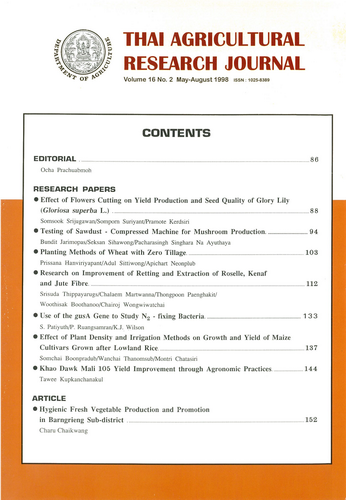Research on Improvement of Retting and Extraction of Roselle, Kenaf and Jute Fibre
DOI:
https://doi.org/10.14456/thaidoa-agres.1998.11Keywords:
retting, extraction, roselle, kenat, juteAbstract
Research on improvement of retting and extraction of roselle, kenaf and jute fibre was growuped into three topics: 1) survey on farm practices. 2) study on major factors that affect retting and extraction process, and 3) development of small retting ponds.rnFarm practices on retting of fibre crops were found in ditch along roadside, in rice field, in farm pond and in natural water resources. These ponds contained 10 - 10 colonies of microorganisms per one milliltre of water.rnRetting in farm pond water took shorter duration (5-6 days) than in rainfall or underground water. Optimum retting temperature ranged between 30-40 C with theoptimum pH of 4-6. Major microorganisms for retting process were released from crop stem.rnFresh bark retting shortened retting duration as same as application of urea at the rate of 0.01 % of fresh stem weight. However, retting duration and water ratio greatly depended on crop species and varieties.rnRepeat retting in the same pond decreased fibre quality. fibre quality improvement was obtained when extracted fibre was washed in clean water. N deficiency plant resulted in delayed retting process or even not completed the process but stayed green and rooting.rnA rectangular pond of 36 sq.metre was sufficient for retting of one rai crop. Recommended retting was fresh bark retting with application of urea 0.01% and covering with water-hyacinth.
Downloads
Published
How to Cite
Issue
Section
License

This work is licensed under a Creative Commons Attribution-NonCommercial-NoDerivatives 4.0 International License.
Thai Agricultural Research Journal



